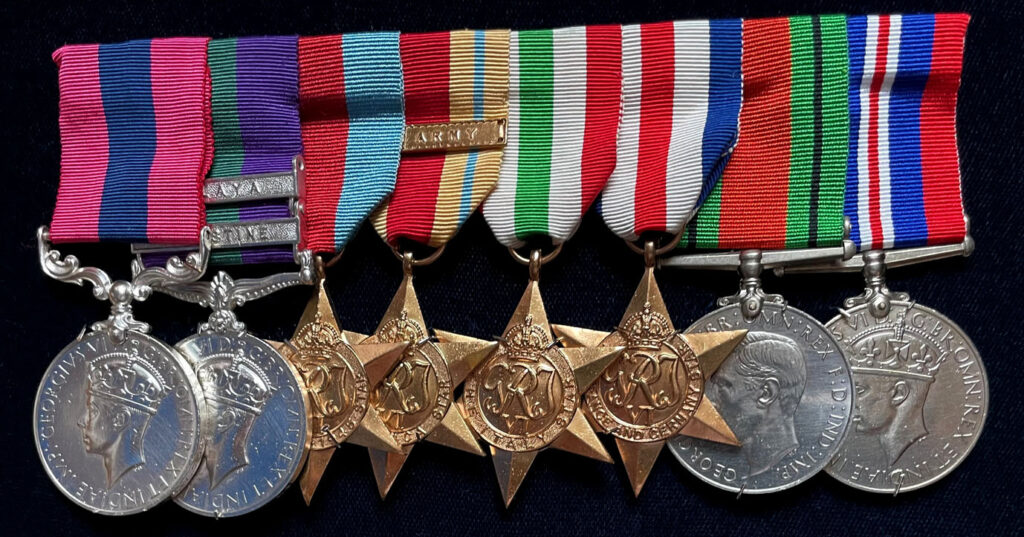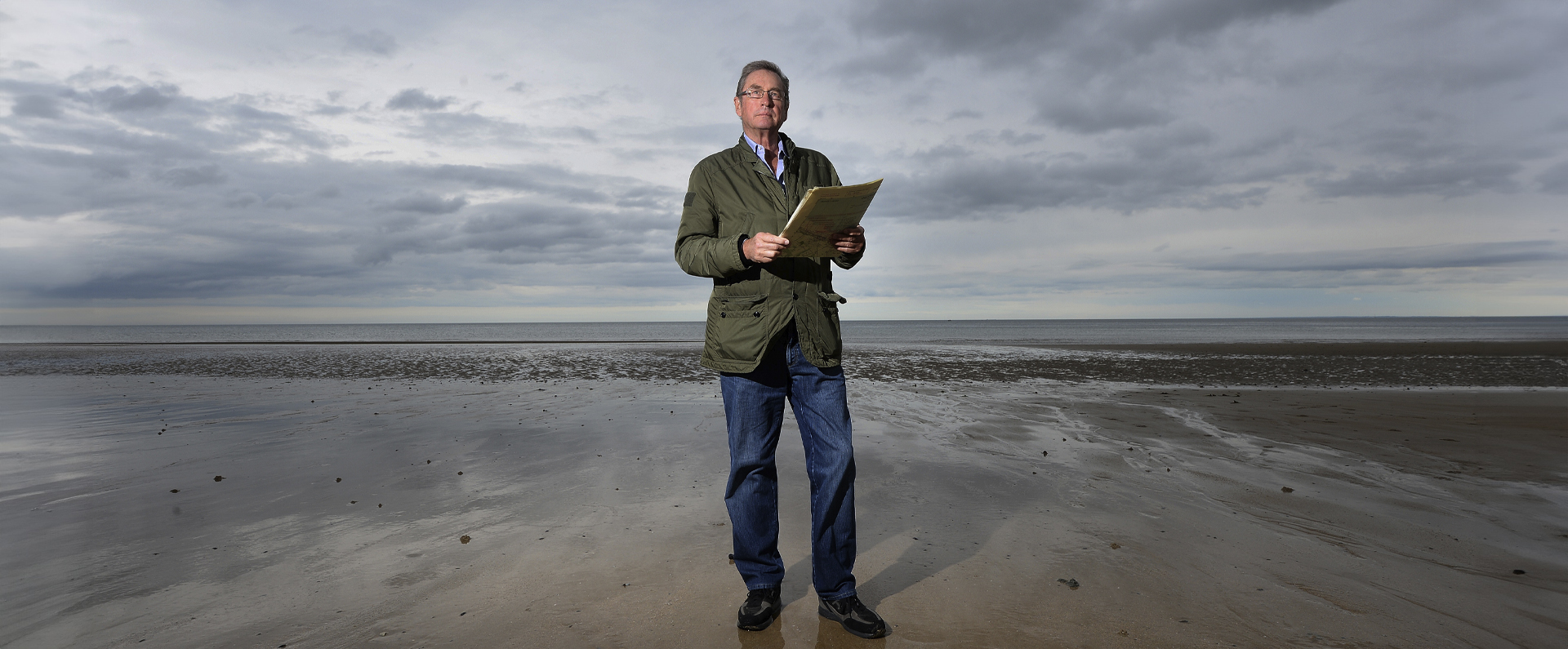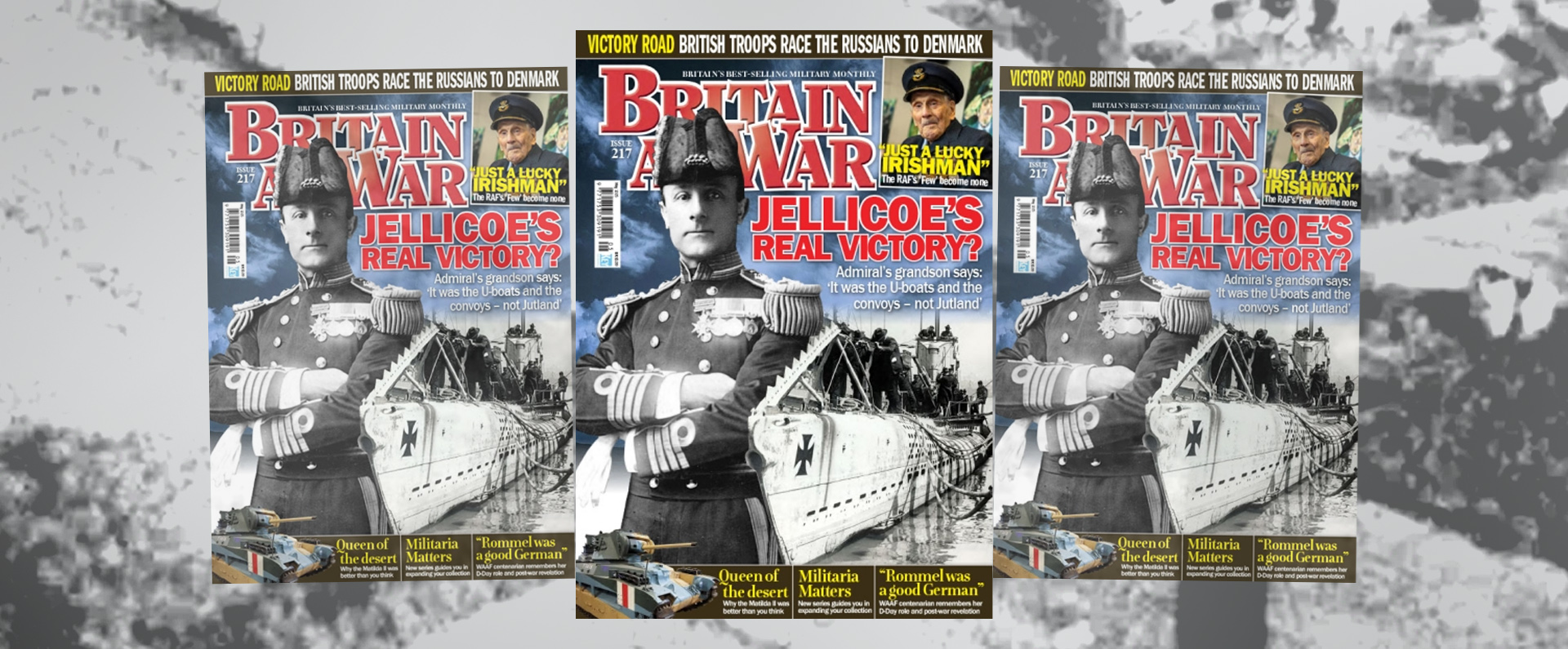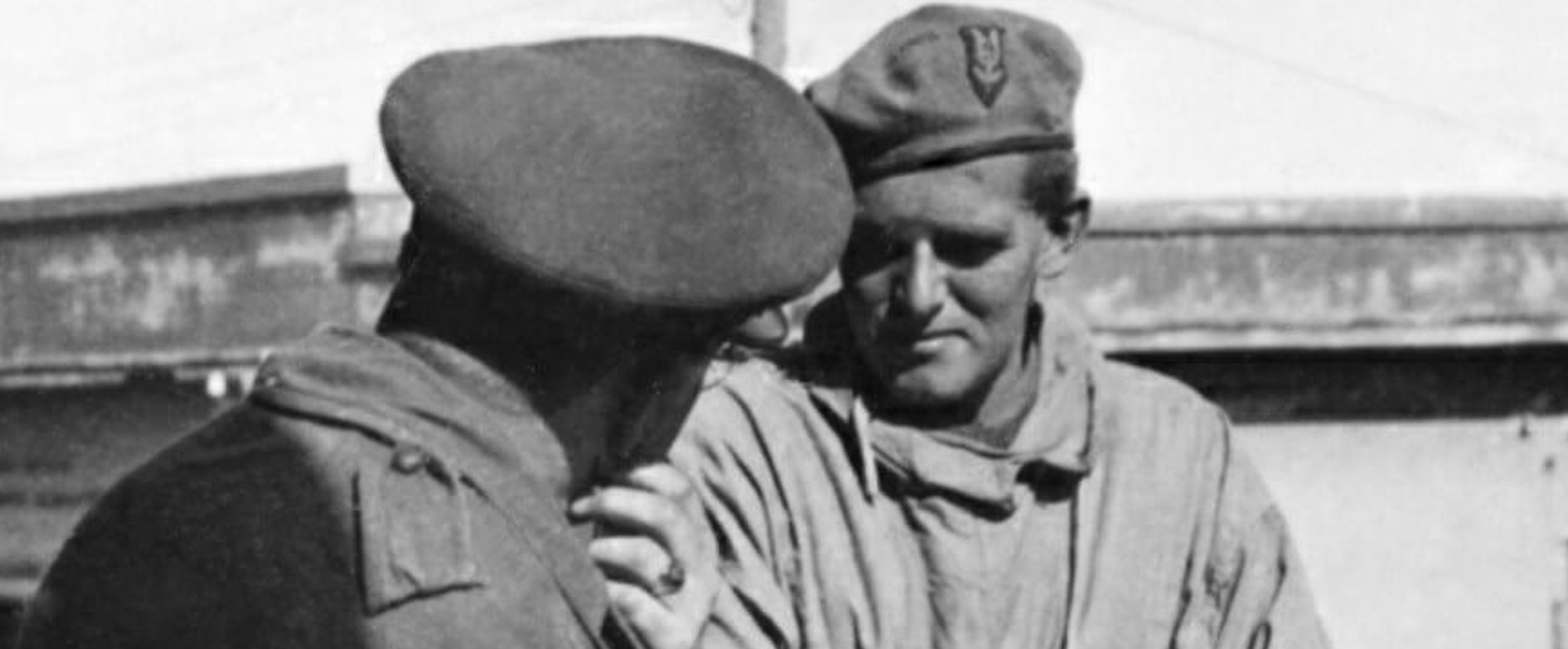
Published in Britain at War in January 2022.
Major Charles George Gibson ‘Pat’ Riley DCM
“Pat” Riley, as he was known to one and all in the Army, had many claims to fame. He was one of the founding fathers of ‘L’ Detachment, SAS Brigade, having joined as one of the legendary “Tobruk Four”, which also included Bob Lilley, Jim Almonds and Jim Blakeney.
Furthermore, he was a renowned pugilist and is believed to have been the only man to have got the better of both Blair “Paddy” Mayne and Reg Seekings, two truly formidable SAS members, in fierce fights. During the war, Riley established himself as one of the SAS’s greatest heroes and he was awarded the DCM for gallantry in North Africa.
Charles George Gibson Riley was born in Redgranite, Wisconsin, USA, on November 24 1915 into an Irish-American family. However, when Riley was just seven, his family moved to Haltwhistle, Cumbria. The eldest of five children, he attended local schools until he was 14, but then went to work in the same granite quarry that employed his father and grandfather. He left his manual job at the end of 1933, aged 18, and on January 15 1934, having already served with the Territorial Army, he joined the Coldstream Guards.
Riley served with the Coldstream Guards in Palestine from October to December 1936 and then transferred to the Army Reserve in December 1937, after which he joined the Wisbech Division of the Isle of Ely Constabulary (now part of Cambridgeshire). He served as a policeman until he was mobilised for service, again with the Guards, in September 1939. Before the outbreak of the Second World War, when both were serving in the Army, Riley twice fought Reg Seekings in the ring, winning on points on both occasions.
After being mobilised, he volunteered for service with 2 Troop, 8 Guards Commando, as part of Layforce, Colonel Robert Laycock’s elite Commando unit. Riley’s Troop was commanded by Jock Lewes, who was destined to become the principal training officer of the SAS. The Troop was operating in the Western Desert in 1941 when it launched a surprise raid in the Fig Tree sector, as part of the defence of Tobruk, the besieged Libyan port, causing considerable casualties. It was during this action that Lewes developed and instigated the new tactics of using a four-man operating team behind enemy lines. As stated earlier, his foremost team of Riley, Almonds, Blakeney and Lilley became known as the ‘Tobruk Four’.
With the disbandment of Layforce, Riley was due to be returned to the 2nd Battalion, Coldstream Guards, but David Stirling, the SAS founder, invited Lewes, together with the ‘Tobruk Four’, into ‘L’ Detachment on the basis of their reputation. Stirling wanted to use small raiding parties to infiltrate behind enemy lines and destroy Rommel’s aircraft and supply dumps. Riley arrived at the ‘L’ Detachment camp at Kabrit (later renamed Kibrit) in the Canal Zone, Egypt, in September 1941 and quickly settled into the rigorous training regime.
Riley took part in the first raid carried out by the unit in November 1941; the attack was supposed to be on the five advanced airfields in the Gazala–Timimi area. However, appalling weather conditions led to a disastrous result: of the 55 individuals who took part in the parachute drop for the raid, only 22 men survived death or captivity. However, ‘L’ Detachment recovered with successful raids, including those on Sirte and Tamit, before embarking on the Bouerat Raid in January 1942.
The backdrop to this raid was that the Axis forces had been driven out of Libya and the capture of Benghazi was imminent. Stirling assessed the situation and concluded that the enemy supply ships would be re-routed to Bouerat, which would, in turn, then become an important harbour for fuel tankers to supply Rommel’s advanced forces. Stirling proposed to Auchinleck that ‘L’ Detachment should enter Bouerat and blow up whatever ships they found, also taking the opportunity to destroy petrol dumps and tankers. Permission was granted and the raid was scheduled for the night of 22/23 January, with the RAF due to bomb Bouerat the following night. The main SAS party, some 20 men strong, was transported to the target by men from the Long Range Desert Group (LRDG).
On the evening of January 22, after a difficult five-day journey from Jalo in Libya, the convoy reached the edge of the Wadi Tamit as the light was fading. The next morning, while sheltering in a wadi [dry gully], they were spotted by enemy planes and bombed and strafed by six aircraft. However, the main group pressed on, and three hours later they reached what was to be their main rendezvous area.
The men were divided by Stirling into two main groups: he would lead one and the other would be led by Riley, and each would approach the harbour from opposite sides. A third smaller group was dispatched to target a wireless station. Stealth was essential and no one was to use a gun unless absolutely necessary. They were to set all their explosives for 2.30am, which would give them plenty of time to get away and meet at their rendezvous point.
On their way back, as they kept close to the road, Stirling’s group and Riley’s group independently came across an enormous car park, with rows of giant petrol carriers, each able to hold some 4,000 gallons of fuel. It was impossible to resist, and soon they had deposited several bombs using one-hour fuses so that these devices would also detonate at 2.30am. The rendezvous point was reached at 1.45am.
As the men headed away with their LRDG escort, they heard explosions shortly after 2.35am and soon the sky in the distance turned a grey-pink. The operation, which only hours earlier had been in danger of turning into a shambles, had ended as a significant triumph: the harbour at Bouerat would be unusable for weeks and many petrol tankers, which were already in short supply, had been destroyed. It was for his courage during the Bouerat Raid that Riley was awarded the DCM on November 26 1942.
After the success of the Bouerat Raid, Stirling returned to Kabrit, where he had left the training of the new recruits in the hands of “Paddy” Mayne. However, Mayne had quickly tired of his new role and resented being away from the action. When Stirling saw that Mayne had effectively downed tools, the two men had an angry argument. Yet Stirling also saw that it was pointless trying to turn a brilliant combatant into an administrator. Instead, Riley was put in charge of training, a role he embraced from the start, fathering and giving confidence to the young soldiers.
Despite this new role, Riley was still scheduled to take part in the next planned series of raids that were due to take place in March 1942. The aim was to target a string of airfields in the Benghazi area but, eventually, most attacks proved unsuccessful: Whereas Riley was well liked by officers and men alike, Mayne had almost as many detractors as he did supporters. Mayne was terrifying in battle but, in drink, he could be terrifying off duty too.
In his book The Regiment: The Real SAS, Michael Asher wrote: “Big Pat Riley, the Wisconsin-born ex-Coldstreamer, was perhaps the only SAS man who ever knocked Mayne down. He once found him drunk, beating someone so savagely it looked as if he might do him real harm. Without even thinking about it, Riley…walloped Mayne with a massive fist and flattened him.”
In September 1942, Riley was heavily involved in the large-scale raid on Benghazi harbour. However, the enemy had been alerted and it proved almost impossible to penetrate the harbour. In the fierce fighting, the SAS lost 50 out of the 200 men involved. After being promoted to regimental sergeant major (RSM), Riley was posted to an Officer Cadet Training Unit (OCTU) in March 1943. He was commissioned into the Queen’s Regiment the following month before returning to the SAS. By the beginning of 1943, with Stirling a PoW and Jock Lewes dead, “Paddy” Mayne took command of the SAS. Riley was appointed commander of ‘C’ Section, No. 1 Troop.
On May 12 1943, the war in North Africa officially came to an end and the SAS – with whom Riley continued to fight – were next called to arms in Sicily and Italy. On July 10 1943, the SAS – by then designated 1 Special Raiding Squadron (SRS) – destroyed a coastal battery at Capo Murro di Porco on Sicily’s eastern coast.
The following day the squadron took part in the first opposed daylight landing of the war – on the beach of Augusta. On September 4, they landed at Bagnara on the Italian mainland, taking the town and securing a bridgehead in preparation for the landing of the main Allied force a few days later. Several fierce battles followed with heavy casualties on both sides. After his role in Italy ended, Riley went to Scotland to help set up a camp at Mauchline, in east Ayrshire, before moving to its permanent camp nearby in Darvel.
After the D-Day landings of June 6 1944, mobility for the SAS was key. Riley ensured that all the new jeeps were properly equipped for action behind the enemy lines. The SAS, by then 2,500 strong under Brigadier Roddie McLeod, was to form a number of bases from which to harry enemy communications, and to work with the French Resistance, blowing up roads and railway lines and reporting to the RAF suitable areas to bomb. After the Armistice, two battalions of the SAS were airlifted to Norway, where Riley assisted with the disarming of the occupying German forces.
In September 1945, the SAS was disbanded and Riley was released to the Army Reserve in November of the same year. He moved back to Cambridgeshire and rejoined the police, serving as a constable in March and Wisbech. Post-war life, however, proved to be too quiet and he volunteered for service as a captain with the Malayan Regiment, working closely with the newly formed Malayan Scouts in their actions against communist insurgents. In fact, the Malayan Scouts became 22 SAS in 1951. By then a major, Riley liaised and worked with the SAS in the persecution of the terrorists, more than 100 of whom were killed or captured.
In late 1955, and having just turned 40, Riley left Malaya and he retired from the Army in July 1959. After military service, he purchased the Dolphin Hotel, essentially a pub, in Colchester, Essex, and ran this for a number of years before taking a managerial role with Securicor.
By the time he retired in 1980, Riley was living in Hastings, East Sussex. His wife, Kay, whom he had married in 1940 and with whom he had a son, died in 1996 and he never really got over her death. Riley, one of the first and most remarkable men ever to serve in the SAS, died in Hastings on February 9 1999, aged 83. I feel privileged to be the custodian of this remarkable man’s medal group having bought them at auction in 2013.
Download a PDF of the original Britain at War article.
For more information, visit:
LordAshcroftOnBravery.com


